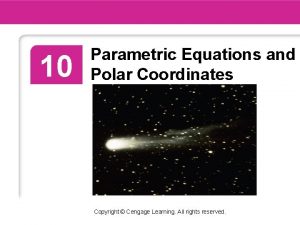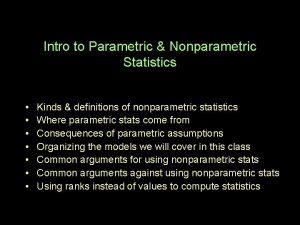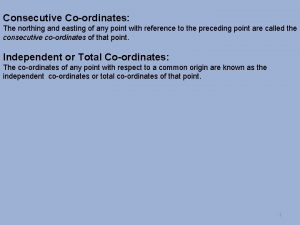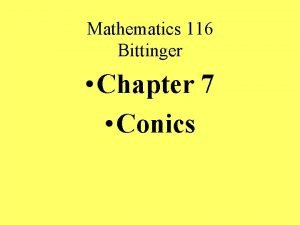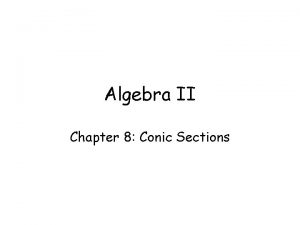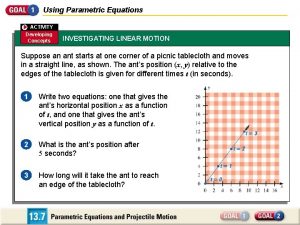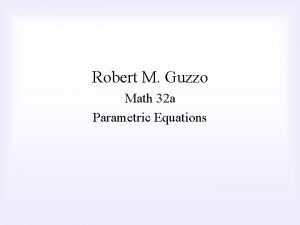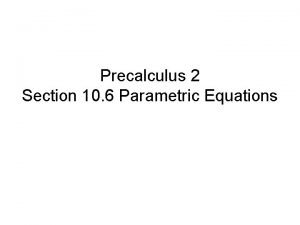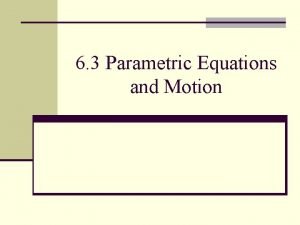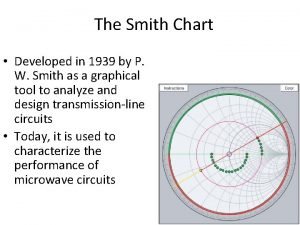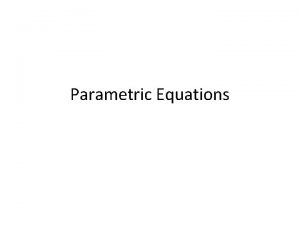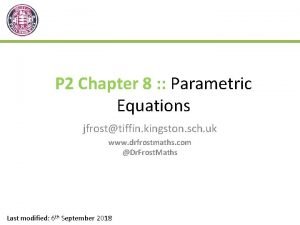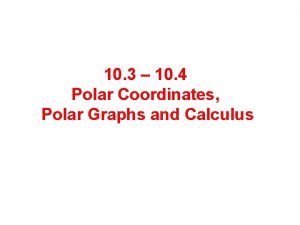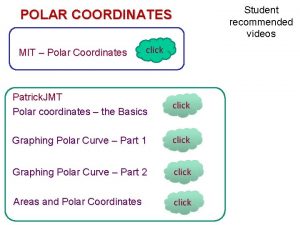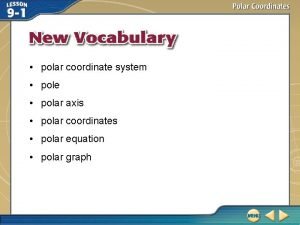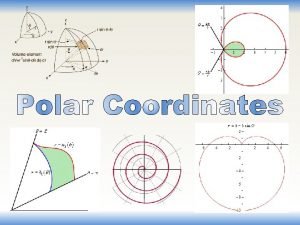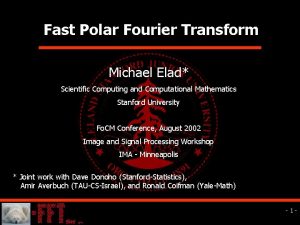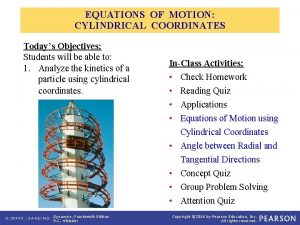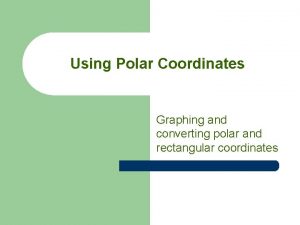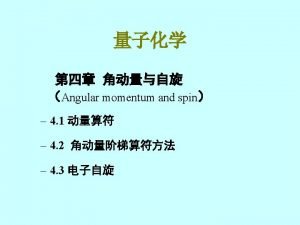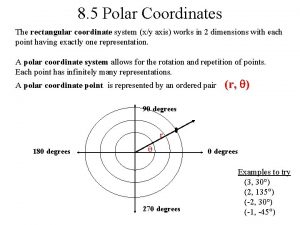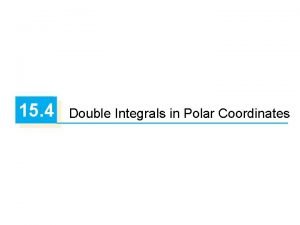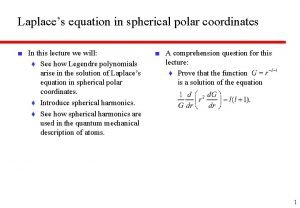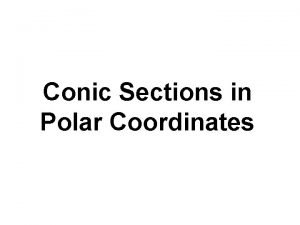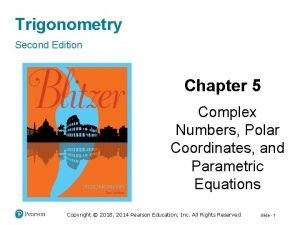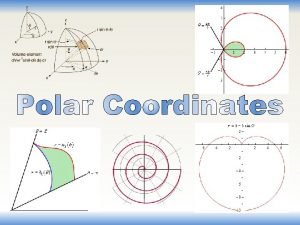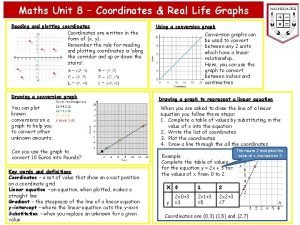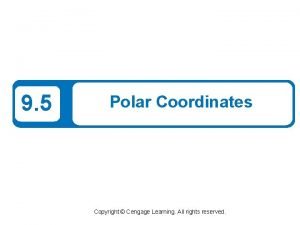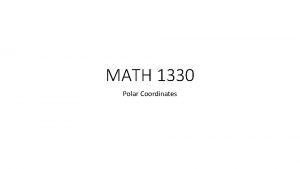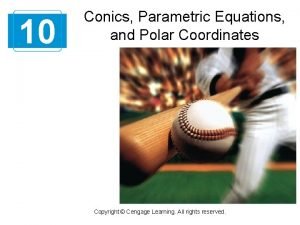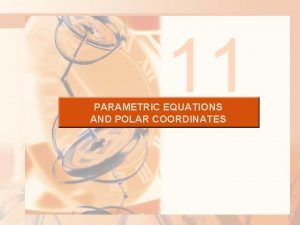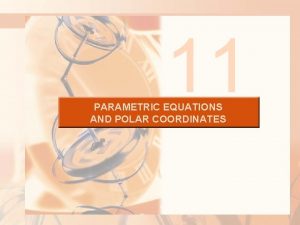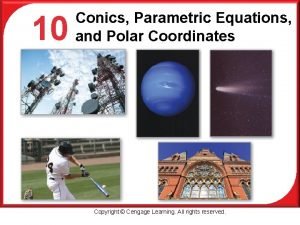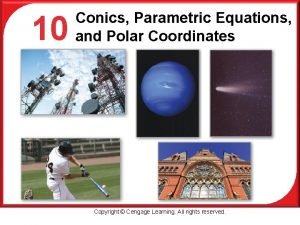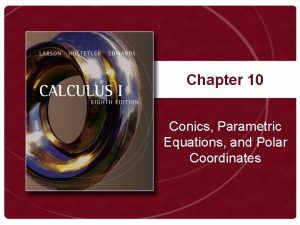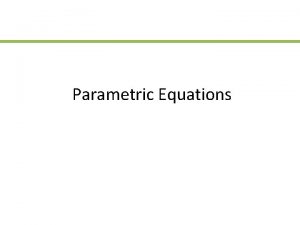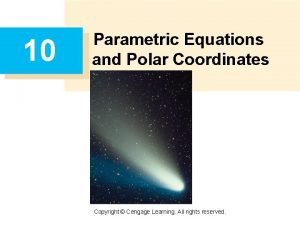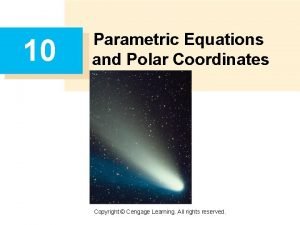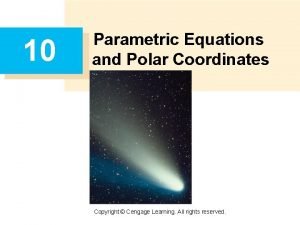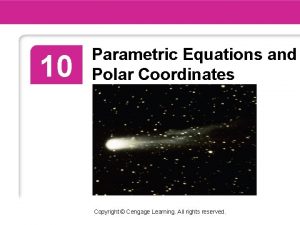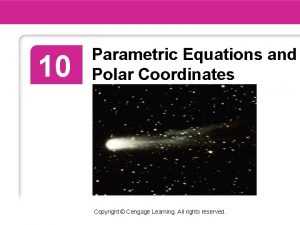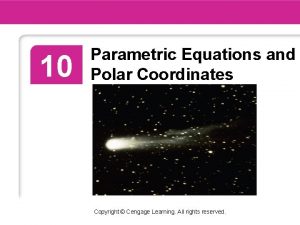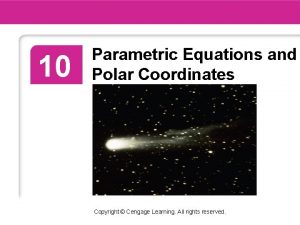10 Conics Parametric Equations and Polar Coordinates Copyright








































- Slides: 40

10 Conics, Parametric Equations, and Polar Coordinates Copyright © Cengage Learning. All rights reserved.

10. 1 Conics and Calculus Copyright © Cengage Learning. All rights reserved.

Objectives n Understand the definition of a conic section. n Analyze and write equations of parabolas using properties of parabolas. n Analyze and write equations of ellipses using properties of ellipses. n Analyze and write equations of hyperbolas using properties of hyperbolas. 3

Conic Sections 4

Conic Sections Each conic section (or simply conic) can be described as the intersection of a plane and a double-napped cone. Notice in Figure 10. 1 that for the four basic conics, the intersecting plane does not pass through the vertex of the cone. Figure 10. 1 5

Conic Sections When the plane passes through the vertex, the resulting figure is a degenerate conic, as shown in Figure 10. 2 6

Conic Sections You could begin as the Greeks did by defining the conics in terms of the intersections of planes and cones, or you could define them algebraically in terms of the general seconddegree equation However, a third approach, in which each of the conics is defined as a locus (collection) of points satisfying a certain geometric property, works best. 7

Conic Sections For example, a circle can be defined as the collection of all points (x, y) that are equidistant from a fixed point (h, k). This locus definition easily produces the standard equation of a circle 8

Parabolas 9

Parabolas A parabola is the set of all points (x, y) that are equidistant from a fixed line called the directrix and a fixed point called the focus not on the line. The midpoint between the focus and the directrix is the vertex, and the line passing through the focus and the vertex is the axis of the parabola. Figure 10. 3 Note in Figure 10. 3 that a parabola is symmetric with respect to its axis. 10

Parabolas 11

Example 1 – Finding the Focus of a Parabola Find the focus of the parabola given by Solution: To find the focus, convert to standard form by completing the square. 12

Example 1 – Solution Comparing this equation with conclude that cont’d you can Because p is negative, the parabola opens downward, as shown in Figure 10. 4. So, the focus of the parabola is p units from the vertex, or Figure 10. 4 13

Parabolas A line segment that passes through the focus of a parabola and has endpoints on the parabola is called a focal chord. The specific focal chord perpendicular to the axis of the parabola is the latus rectum. One widely used property of a parabola is its reflective property. In physics, a surface is called reflective if the tangent line at any point on the surface makes equal angles with an incoming ray and the resulting outgoing ray. The angle corresponding to the incoming ray is the angle of incidence, and the angle corresponding to the outgoing ray is the angle of reflection. One example of a reflective surface is a flat mirror. 14

Parabolas Another type of reflective surface is that formed by revolving a parabola about its axis. A special property of parabolic reflectors is that they allow us to direct all incoming rays parallel to the axis through the focus of the parabola—this is the principle behind the design of the parabolic mirrors used in reflecting telescopes. Conversely, all light rays emanating from the focus of a parabolic reflector used in a flashlight are parallel, as shown in Figure 10. 6 15

Parabolas 16

Ellipses 17

Ellipses An ellipse is the set of all points (x, y) the sum of whose distances from two distinct fixed points called foci is constant. (See Figure 10. 7. ) Figure 10. 7 The line through the foci intersects the ellipse at two points, called the vertices. 18

Ellipses The chord joining the vertices is the major axis, and its midpoint is the center of the ellipse. The chord perpendicular to the major axis at the center is the minor axis of the ellipse. (See Figure 10. 8. ) Figure 10. 8 19

Ellipses 20

Ellipses You can visualize the definition of an ellipse by imagining two thumbtacks placed at the foci, as shown in Figure 10. 9. If the ends of a fixed length of string are fastened to the thumbtacks and the string is drawn taut with a pencil, the path traced by the pencil will be an ellipse. Figure 10. 9 21

Example 3 – Analyzing an Ellipse Find the center, vertices, and foci of the ellipse given by Solution: By completing the square, you can write the original equation in standard form. 22

Example 3 – Solution cont’d So, the major axis is parallel to the y-axis, where h = 1, k = – 2, a = 4, b = 2, and c = = So, you obtain the following. The graph of the ellipse is shown in Figure 10. 10 23

Ellipses One of the reasons that astronomers had difficulty in detecting that the orbits of the planets are ellipses is that the foci of the planetary orbits are relatively close to the center of the sun, making the orbits nearly circular. 24

Ellipses To measure the ovalness of an ellipse, you can use the concept of eccentricity. 25

Ellipses To see how this ratio is used to describe the shape of an ellipse, note that because the foci of an ellipse are located along the major axis between the vertices and the center, it follows that 0 < c < a. Figure 10. 12 26

Ellipses For an ellipse that is nearly circular, the foci are close to the center and the ratio c/a is small, and for an elongated ellipse, the foci are close to the vertices and the ratio c/a is close to 1, as shown in Figure 10. 12. Note that 0 < e < 1 for every ellipse. 27

Ellipses The orbit of the moon has an eccentricity of e = 0. 0549, and the eccentricities of the eight planetary orbits are as follows. You can use integration to show that the area of an ellipse is 28

Ellipses For instance, the area of the ellipse is given by However, it is not so simple to find the circumference of an ellipse. 29

Hyperbolas 30

Hyperbolas A hyperbola is the set of all points (x, y) for which the absolute value of the difference between the distances from two distinct fixed points called foci is constant. (See Figure 10. 14. ) The line through the two foci intersects a hyperbola at two points called the vertices. Figure 10. 14 31

Hyperbolas The line segment connecting the vertices is the transverse axis, and the midpoint of the transverse axis is the center of the hyperbola. One distinguishing feature of a hyperbola is that its graph has two separate branches. 32

Hyperbolas 33

Hyperbolas An important aid in sketching the graph of a hyperbola is the determination of its asymptotes, as shown in Figure 10. 15. Each hyperbola has two asymptotes that intersect at the center of the hyperbola. The asymptotes pass through the vertices of a rectangle of dimensions 2 a by 2 b, with its center at (h, k). The line segment of length 2 b joining (h, k + b) and (h, k – b) is referred to as the conjugate axis of the hyperbola. Figure 10. 15 34

Hyperbolas 35

Hyperbolas In Figure 10. 15 you can see that the asymptotes coincide with the diagonals of the rectangle with dimensions 2 a and 2 b, centered at (h, k). This provides you with a quick means of sketching the asymptotes, which in turn aids in sketching the hyperbola. Figure 10. 15 36

Example 7 – Using Asymptotes to Sketch a Hyperbola Sketch the graph of the hyperbola whose equation is 4 x 2 – y 2 = 16. Solution: Begin by rewriting the equation in standard form. The transverse axis is horizontal and the vertices occur at ( – 2, 0) and (2, 0). The ends of the conjugate axis occur at (0, – 4) and (0, 4). 37

Example 7 – Solution cont’d Using these four points, you can sketch the rectangle shown in Figure 10. 16(a). By drawing the asymptotes through the corners of this rectangle, you can complete the sketch as shown in Figure 10. 16(b). Figure 10. 16 38

Hyperbolas 39

Hyperbolas As with an ellipse, the eccentricity of a hyperbola is e = c/a. Because c > a for hyperbolas, it follows that e > 1 for hyperbolas. If the eccentricity is large, the branches of the hyperbola are nearly flat. If the eccentricity is close to 1, the branches of the hyperbola are more pointed, as shown in Figure 10. 17 40
 Polar curve
Polar curve Convert polar coordinates to rectangular coordinates
Convert polar coordinates to rectangular coordinates Univariate statistical tests
Univariate statistical tests Parametric and nonparametric tests
Parametric and nonparametric tests Parametric and non parametric algorithms
Parametric and non parametric algorithms Polar graphs
Polar graphs Parametric
Parametric Consecutive coordinates are also known as
Consecutive coordinates are also known as Chapter 7 conic sections and parametric equations
Chapter 7 conic sections and parametric equations Dot product properties
Dot product properties Rectangular equations to polar equations
Rectangular equations to polar equations Conics summary sheet
Conics summary sheet Parametric equations activity
Parametric equations activity Parametric equations word problems
Parametric equations word problems Precalculus parametric equations
Precalculus parametric equations Parametric equation of motion
Parametric equation of motion How to solve parametric equations
How to solve parametric equations Complete smith chart
Complete smith chart Parametric equations
Parametric equations Dr frost parametric equations
Dr frost parametric equations Area between 2 curves formula
Area between 2 curves formula Pole in polar coordinates
Pole in polar coordinates Pole in polar coordinates
Pole in polar coordinates Polar coordinates art project
Polar coordinates art project Line in polar coordinates
Line in polar coordinates Polar parameterization
Polar parameterization Polar fourier series
Polar fourier series Equation of motion cylindrical coordinates
Equation of motion cylindrical coordinates Rectangular to polar form
Rectangular to polar form Symmetry polar equations
Symmetry polar equations Y=rsin
Y=rsin Type of conic
Type of conic Continuity of a function
Continuity of a function Polar coordinates to rectangular
Polar coordinates to rectangular Double integrals in polar coordinates
Double integrals in polar coordinates Laplace equation in spherical polar coordinates
Laplace equation in spherical polar coordinates Conic sections in polar coordinates
Conic sections in polar coordinates How to find rectangular coordinates
How to find rectangular coordinates Polar coordinates
Polar coordinates Real life graphs
Real life graphs Multiple representations of polar coordinates
Multiple representations of polar coordinates
